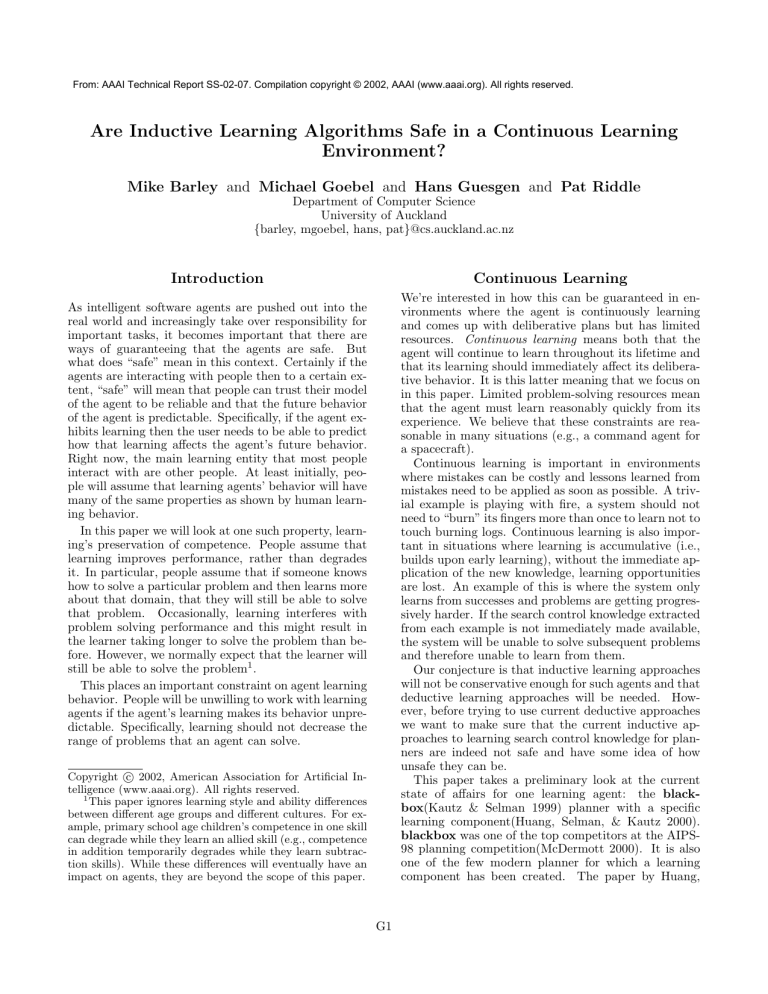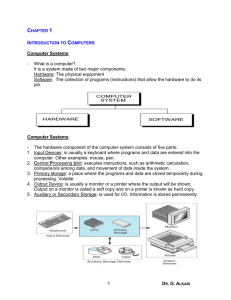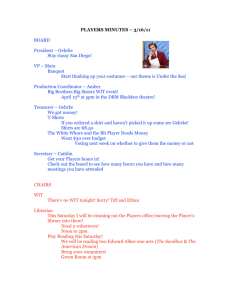
From: AAAI Technical Report SS-02-07. Compilation copyright © 2002, AAAI (www.aaai.org). All rights reserved.
Are Inductive Learning Algorithms Safe in a Continuous Learning
Environment?
Mike Barley and Michael Goebel and Hans Guesgen and Pat Riddle
Department of Computer Science
University of Auckland
{barley, mgoebel, hans, pat}@cs.auckland.ac.nz
Introduction
Continuous Learning
We’re interested in how this can be guaranteed in environments where the agent is continuously learning
and comes up with deliberative plans but has limited
resources. Continuous learning means both that the
agent will continue to learn throughout its lifetime and
that its learning should immediately affect its deliberative behavior. It is this latter meaning that we focus on
in this paper. Limited problem-solving resources mean
that the agent must learn reasonably quickly from its
experience. We believe that these constraints are reasonable in many situations (e.g., a command agent for
a spacecraft).
Continuous learning is important in environments
where mistakes can be costly and lessons learned from
mistakes need to be applied as soon as possible. A trivial example is playing with fire, a system should not
need to “burn” its fingers more than once to learn not to
touch burning logs. Continuous learning is also important in situations where learning is accumulative (i.e.,
builds upon early learning), without the immediate application of the new knowledge, learning opportunities
are lost. An example of this is where the system only
learns from successes and problems are getting progressively harder. If the search control knowledge extracted
from each example is not immediately made available,
the system will be unable to solve subsequent problems
and therefore unable to learn from them.
Our conjecture is that inductive learning approaches
will not be conservative enough for such agents and that
deductive learning approaches will be needed. However, before trying to use current deductive approaches
we want to make sure that the current inductive approaches to learning search control knowledge for planners are indeed not safe and have some idea of how
unsafe they can be.
This paper takes a preliminary look at the current
state of affairs for one learning agent: the blackbox(Kautz & Selman 1999) planner with a specific
learning component(Huang, Selman, & Kautz 2000).
blackbox was one of the top competitors at the AIPS98 planning competition(McDermott 2000). It is also
one of the few modern planner for which a learning
component has been created. The paper by Huang,
As intelligent software agents are pushed out into the
real world and increasingly take over responsibility for
important tasks, it becomes important that there are
ways of guaranteeing that the agents are safe. But
what does “safe” mean in this context. Certainly if the
agents are interacting with people then to a certain extent, “safe” will mean that people can trust their model
of the agent to be reliable and that the future behavior
of the agent is predictable. Specifically, if the agent exhibits learning then the user needs to be able to predict
how that learning affects the agent’s future behavior.
Right now, the main learning entity that most people
interact with are other people. At least initially, people will assume that learning agents’ behavior will have
many of the same properties as shown by human learning behavior.
In this paper we will look at one such property, learning’s preservation of competence. People assume that
learning improves performance, rather than degrades
it. In particular, people assume that if someone knows
how to solve a particular problem and then learns more
about that domain, that they will still be able to solve
that problem. Occasionally, learning interferes with
problem solving performance and this might result in
the learner taking longer to solve the problem than before. However, we normally expect that the learner will
still be able to solve the problem1 .
This places an important constraint on agent learning
behavior. People will be unwilling to work with learning
agents if the agent’s learning makes its behavior unpredictable. Specifically, learning should not decrease the
range of problems that an agent can solve.
c 2002, American Association for Artificial InCopyright !
telligence (www.aaai.org). All rights reserved.
1
This paper ignores learning style and ability differences
between different age groups and different cultures. For example, primary school age children’s competence in one skill
can degrade while they learn an allied skill (e.g., competence
in addition temporarily degrades while they learn subtraction skills). While these differences will eventually have an
impact on agents, they are beyond the scope of this paper.
G1
The blackbox variation of the sandbox learning protocol uses a training problem set to both learn the candidate rule set and to run the quality assurance test. As
in the standard sandbox learning protocol, the blackbox variation keeps the learned SCRs separate from
those actually used by the planner. We call the set
of SCRs that are being learned, the candidate rule set.
We call the set of SCRs used by the planner, the performance rule set. The blackbox sandbox protocol does
two runs over the problem set. The first run creates
the candidate search control rule set and the second
run verifies that none of the candidate SCRs reject any
solution found by blackbox during the first run. Any
rule in the candidate set that rejects a solution is pruned
away.
In the first run, blackbox runs sequentially on the
problems in the problem set. For each problem in the
problem set, if blackbox solves that problem then it
uses the solution as a collection of training examples
from which it creates new SCRs, which are added to
the candidate rule set.
In the second run, the learner verifies the candidate
rule set against the solution found in the first run for
each problem in the training problem set. Any rule that
rejects that solution is pruned away. The search control
rule set produced by this second run is guaranteed not
to reject any solution that the planner would find with
the original performance rule set for the training problem set. However, there still may be other problems
outside of that training set where the new performance
rule set rejects all the solutions but where the original
performance rule set does not.
The sandbox protocol for safe learning is reasonable for many situations. In fact, it is the standard
protocol one uses for software releases. However, it
doesn’t satisfy our goals for a continuously learning
agent. Its learning is not immediately available to affect
the agent’s behavior, instead the newly learned rules are
placed in a candidate rule set isolated from the planner. Additionally, when learning continuously, there are
questions about how large to make the sandbox. The
smaller the sandbox is, the larger the chance will be
of adding a new SCR to the performance engine that
will prevent it from solving some future problem. The
larger the sandbox is, the longer the delay will be between learning the rule and deploying it in the performance engine. It’s not obvious how to automatically
balance these concerns.
This paper examines what happens to the safeness of
the learned SCRs if we adopt an incremental protocol
for learning. In this approach, the search controls are
added to the current rule set as they are learned.
Selman, and Kautz(Huang, Selman, & Kautz 2000) describes experiments with the learner that show that the
learned search control rules (SCRs) can dramatically
improve blackbox’s performance (speeding up the planner’s performance on some problems by over two orders
of magnitude). What is missing, from our perspective,
is how well the learner preserves blackbox’s coverage of
past problem solved.
In the next section we very briefly describe blackbox and its learner. In the section following that, we
describe blackbox’s current approach (using a sandbox for the learned rules) to making its learning safer
and why it’s not appropriate for continuous learning
environments. In the penultimate section, we describe
our experiment and in the last two sections we discuss
future research and conclude.
blackbox and its Learner
blackbox allows one to specify a number of different
planners to be used in solving a problem. In our experiment, we use the graphplan(Blum & Furst 1997)
planner. graphplan can detect that certain goals are
mutually exclusive (mutex -ed) based on the problem’s
constraints. This enables it to avoid working on problems which it can show are impossible for it to solve.
However, its algorithm for detecting mutex es is incomplete.
blackbox’s learner is a variant of Quinlan’s
FOIL(Quinlan 1996) that learns relational search control rules. These search control rules are expressed in
a temporal logic language which only references world
state predicates and final goal predicates. This avoids
the problem of SCRs interfering with each other at the
meta-level(Barley & Guesgen 2001).
Sandbox Safety
One common protocol for providing safe learning, which
we call the sandbox learning protocol, is to quarantine
the learned SCRs from the performance engine. Even if
the learning is going on in real-time, the new rules are
kept isolated from the performance part of the system.
The learner proposes new candidate sets of SCRs and
these candidate sets are screened by a quality assurance
process. Only when a candidate set passes the quality
assurance process can it become the new SCR rule set.
blackbox has a number of runtime switches that
enable blackbox to select from a number of different
learning protocols. One combination allows blackbox
to follow a variation of the sandbox protocol. The variation2 described next is the one used in the experiments
described by Huang, Selman, and Kautz(Huang, Selman, & Kautz 2000) which we mentioned in the section. We first provide an overview of blackbox’s variation and then we look at it in slightly more detail.
The Experiment
Our experiment is to explore how safe blackbox’s
learning algorithm is when using an incremental learning protocol. In this protocol, search control rules
learned from solving a problem are added to the current
search control rule set which will be used in attempting
2
What we provide here is a simplified description of the
variation. This simplified version is functionally equivalent
to the actual protocol used.
G2
enough memory and how many of those would have remained solvable (given enough memory). The third row
is uninteresting.
The ambiguity of the second row’s information affects our ability to predict how much incremental learning would have affected blackbox’s performance if it
had had more memory. We will only look at the best
case for incremental learning, i.e., where the lowest percentage of solved problems became mutex-ed problems.
The best case would be if the 5.1 problems that went
from killed to mutex (on average) would not have been
solvable even with unlimited memory and that the 8.1
problems (on average) that went from killed to killed
would have been solved both with out and with incremental learning if there had been enough memory. If
this had been the case then we would have had 23.15
problems that were solved without incremental learning
and 13.1 problems that were still solved with incremental learning. So, in the best case, approximately 40% of
the problems that were solvable without learning would
become mutex using incremental learning. From this it
is fairly clear that blackbox’s learning algorithm is not
safe for this incremental learning protocol.
to solve the next problem. This incremental learning
protocol is the approach we expect to be used by agents
that can continuously learn from their experience.
For this experiment, we took one of the domains,
mprime, that blackbox attempted in the AIPS-98
competition. In this experiment, we did two runs.
The first run (which we call the base run) is without any search control rules. This partitions the problems into three parts: problems blackbox solved, problems blackbox can definitely not solve (mutex-ed), and
problems where blackbox ran out of resources before
solving the problem or finding out that it was unsolvable. Problems where blackbox ran out of resources,
we call killed problems. We ran blackbox without any
time limits but there was a 256 MB memory limit. All
killed problems ran out of memory. blackbox can à
priori detect some of the problems that it definitely
cannot solve from its SAT encoding3 of the problem.
If it cannot find mutex -free goals then it won’t be able
to solve the problem. We call these problems, mutex -ed
problems.
We then did a hundred more runs, each one using an
incremental learning protocol. For each of these learning runs, the problems were randomly ordered. Our incremental learning protocol consisted of starting with
an empty search control rule set and trying to solve
the first problem in the selected random ordering. If
the problem is not solved then blackbox does not attempt to learn any search control rules. If the problem
is solved then blackbox attempts to learn new rules4 .
If any rules are learned, these are added to the performance rule set. The next problem in the selected ordering is then attempted and this incremental learning
process continues until we have run out of problems.
Figure 1 shows the effects of incremental learning on
the planner’s competence. Specifically, it shows what
happens to the planner’s ability to solve problems as it
incrementally learns from its experience. As we see on
the rightmost column, with no SCRs (and no learning)
blackbox was able to solve 15 of the 30 problems and
found it was definitely unable to solve one problem. For
the remaining 14 problems it ran out of resources. The
first row is the most interesting and informative row.
From the first row, we see that if we use incremental
learning that, on average, 4.1 of those 15 problems remained solved, while 10.2 become definitely unsolvable
(i.e., mutex) and for 0.7 of them, the planner will run
out of resources. Unfortunately, the information in the
second row is ambiguous. We have no idea how many of
those 5.1 problems (if any) would originally have been
solved if the memory limit had been sufficiently high.
We also know nothing about which of the 8.1 problems
would have been originally solvable if there had been
Future Research
In our past work, we showed that using certain types
of meta-level predicates in the preconditions of SCRs
can lead to learned rules having counter-intuitive effects upon the performance engine(Barley & Guesgen
2001). These counter-intuitive effects could cause unsafe behavior.
In this paper, we showed that avoiding using these
types of meta-level predicates in SCR preconditions is
not sufficient to guarantee that learned rules will not
cause unsafe planner behavior. We showed that using the incremental learning protocol with an inductive
learning algorithm can lead to unsafe behavior, namely,
loss of domain coverage.
Our goal is to develop a learning algorithm which is
guaranteed to be safe to use with the incremental learning protocol. Our next step is to look at the current
state of deductive SCR learners. In the past, deductive
learners used EBL to derive approximately sufficient
conditions for search control actions. They were approximations6 because they normally left out portions
of the full explanations. We will be looking at current
deductive SCR learners to see if that is still true and
also to explore sound ways of generalizing the explanation beyond the example it explains.
Conclusions
In this paper, we attempted to accomplish four things:
3
blackbox initially transforms a planning problem into a
boolean SAT encoding of a constraint satisfaction problem,
we will not discuss this further in this paper. Blum and
Furst describe this in (Blum & Furst 1997).
4
Learning from failure has not been implemented in
blackbox
5
The 15 problems that were solved with the current memory limit and the 8.1 killed problems we are assuming would
have been solved if given enough memory.
6
EBL-derived SCRs were usually both under-generalized
and over-generalized.
G3
/ with SCRs | solved
| killed | mutex
# totals |
no SCRs
|
|
|
#(no SCRs)|
------------------------------------------------#---------|
solved
| 4.1(2.1) | 0.7(0.6) | 10.2(1.9) # 15
|
------------------------------------------------#---------|
killed
| 0.8(0.8) | 8.1(1.7) | 5.1(2.2) # 14
|
------------------------------------------------#---------|
mutex
|
0(0)
|
0(0)
|
1(0)
#
1
|
================================================#=========|
totals
|
|
|
#
|
(with SCRs) | 4.9(2.9) | 8.8(2.3) | 16.3(4.1) # 30
|
================================================#=========|
The entries in the boxes are ‘‘mean(standard deviation)’’.
Figure 1: Problem-Solving Performance with and without SCRs
1. Argue that the safeness of an agent, to some extent,
depends upon how well the system’s behavior mirrors
the user’s expectations of its behavior. In this case,
the expectation is that learning should not decrease
the range of problems the system can solve.
In Proceedings of the Seventeenth International Conference on Machine Learning.
Kautz, H., and Selman, B. 1999. Unifying SAT-based
and graph-based planning. In Proceedings of the Sixteenth International Joint Conference on Artificial Intelligence, 318–325.
McDermott, D. 2000. The 1998 ai planning systems
competition. AI Magazine 21(2):35–55.
Quinlan, J. 1996. Learning first-order definitions of
functions. Journal of Artificial Intelligence Research
5:139–161.
2. Identify an important class of situations where the
current approach to safe learning (the sandbox learning protocol) is not appropriate. Namely, situations
where continuous learning is important when it is desirable to be able to immediately deploy the learned
rules.
3. Show that inductive learning is not always safe for
learning SCRs using the incremental learning protocol.
4. Suggest where we should go next in our search for a
learning algorithm that will be safe (with respect to
preservation of domain coverage) using the incremental learning protocol.
Acknowledgments
We thank Yi-Cheng Huang and the members of the
blackbox group for making their planner/learner code
available to us and for taking the time to answer our
many questions. We also thank Ella Atkins and Diana Spears for their many constructive comments and
suggestions.
References
Barley, M., and Guesgen, H. 2001. Meta-level preconditions: An obstacle to safe SCR learning. In IC-AI
2001 Conference Proceedings. LasVegas, Nevada,USA:
2001 International Conference on Artificial Intelligence.
Blum, A., and Furst, M. 1997. Fast planning through
planning graph analysis. Artificial Intelligence.
Huang, Y.; Selman, B.; and Kautz, H. 2000. Learning
declarative control rules for constraint-based planning.
G4



